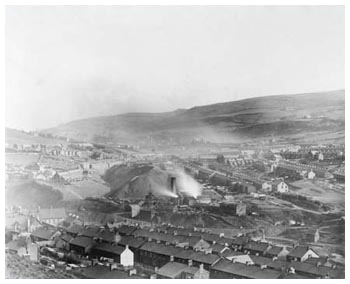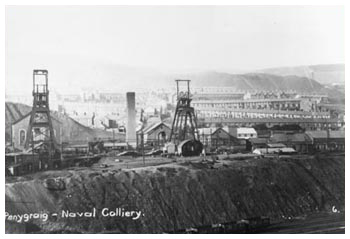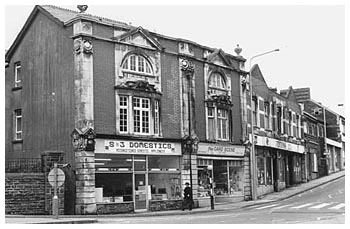
| Penygraig | |
Penygraig Circa 1900
|
The English translation of Penygraig would be top or head of the rock. The original settlement in this area, as shown on the 1840's tithe map was known as Ffrwd Amos, a relic of which still exists in the name of today's street Amos Hill. However the first mine in the area was called Pen-y-Graig, which quickly became the accepted name of the village that grew up around it.The beginnings of Penygraig as a village, in common with most of the Rhondda, stem from the advent of mining in the area. Before this it was already existed as a religious centre for Welsh Baptists in Mid-Rhondda prior to the sinking of its first pit. According to ‘Soariana' The History of Soar Welsh Baptist Church published in 1905, a Mr. William David started the Baptist cause in Penygraig and Dinas. Upon moving to the area in 1811, as overseer of Dinas Colliery and as publican of The White Rock, he gave a room at White Rock Terrace for the purpose of holding religious meetings. |
| Meetings were held both here and later at Penygelli School, then in May 1830 a parcel of land at Ffrwdamos was acquired and the building of Soar Chapel commenced. The chapel was officially opened in February 1832, having cost £300 to build. It was subsequently rebuilt in 1858 and extended in 1875, finally undergoing another rebuilding in 1903. Coal mining at Penygraig began in 1857when Thomas Ellis sank a drift mine in the district to the bituminous coal seam. Then in 1858 Moses Rowlands and Richard Jenkins found an outcrop to the No.2 Rhondda Seam at the Penygraig level. Rowlands then joined with William Williams, William Morgan and John Crockett to form the Penygraig Coal Company, which sank a pit, The Penygraig Colliery. This pit, sunk to the No.3 Rhondda Seam, prospered and by 1870 production reached nearly 100,00 tons annually. Subsequently the Naval Colliery Company opened a new shaft at Penygraig, known as the Pandy Pit it succeeded in reaching the steam coal measures in 1879. After a number of setbacks the pit was sold to The New Naval Colliery Company in 1887. This company extended the existing leases and sank three new collieries, The Ely, Nantgwyn and Anthony Pits. The company eventually went on to become a part of the Cambrian Combine. |
|
| It was at the Ely Colliery Penygraig that the strike known as the Cambrian Colliery Dispute, one of the bitterest in British industrial history, which eventually led to the unrest known as ‘The Tonypandy riots', began. The dispute began over prices for working a new seam and escalated when management locked out all workers at the Ely Colliery leading eventually to strikes throughout the Combine's mines. The collieries at Penygraig suffered a number of disasters that emphasised the dangerous nature of the mining industry. On December the fourth 1875 water flooded the mine drowning two workers and endangering the lives of many others. Then in December 1880 a major disaster occurred at the Naval Colliery described by the official report into the disaster thus: |
|
| ‘One hundred and one lives were lost in an explosion which occurred at the Naval Steam Coal Colliery at Penygraig belonging to Messrs. Rowlands and Morgan about 1.30a.m. on the morning of Friday 10th December 1880. Only five men of all who were in the colliery survived.' | |
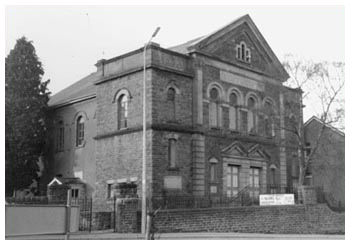 |
Again in January 1884 another explosion at the same colliery led to the death of fourteen men, eleven from the explosion and three from suffocation. Then in August 1909 a shaft accident involving two cages, one of them full with men about to begin their shift, led to the deaths of six men and serious injury to eighteen others. Left: Soar Chapel |
| PENYGRAIG INDUSTRIAL CO-OPERATIVE SOCIETY | |
| The origin of the Cooperative movement began with the Rochdale Pioneers in 1844, and was based on a few simple principles. Every member must invest in the Society by buying shares, and all goods sold in its stores would be sold at a fair price with all profits being returned to the society and also to its members via a dividend based on the amount purchased. Each branch of the Society was part of a cooperative network but would be set up and run locally. In 1941 The Penygraig Industrial Co-Operative Society produced a booklet marking the fiftieth anniversary of the Society's founding in the village. This booklet outlines the early years of the society in Penygraig and the struggle of the pioneers of the Society to make it a success. |
Co-operative building, Tylacelyn Road circa 1988
|
| The origins of the Society in Penygraig date back to 1891 when at a meeting at The Butchers Arms public house Morgan Thomas, Obadiah Williams, and David Williams amongst others declared their intention to, ‘initiate the movement of staring a Co-Operative Society'. This intention met with a great deal of resistance from many of the people in the locality, some of whom had lost money in a failed attempt to start such a society nearby in Tonypandy only a couple of year previously. Due to a number of objections to holding their meetings in a public house subsequently the Society's meetings were held at Fosters Coffee Tavern. Initially 46 members agreed to join the Society and Morgan Thomas became its first chairman, with Obadiah Williams its Secretary and David Williams its Treasurer. Shop premises were purchased for a sum of £950 pounds from Moses Rowlands (the sum loaned from the father-in-law of the Society's first manager) and Evan Treharne was appointed manager at a wage of ‘£8 per lunar month', with his wife also receiving £2. A trademark of a bee was chosen, advertising handbills were distributed, dividend and shop books ordered and £250 worth of goods to stock the shop was purchased With its rules and regulations approved the Society was officially established on August 8th 1891. |
|
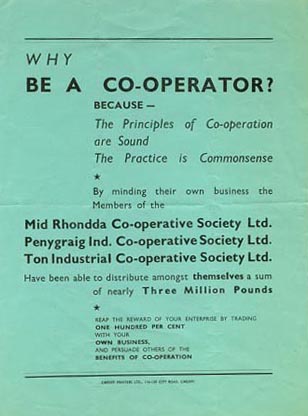 |
The first years of the Society were a struggle, by 1901 membership had only reached 120 and weekly sales were only about £100. This was to change with the appointment of a new manager, William Job, who during his tenure oversaw a great expansion of the enterprise so that by the time he died, in 1937, membership was 6,200 and turnover over £6,000 per week.During his tenure as manager the Society opened a new bakery in Penygraig as well as branches in Tonyrefail, Gilfach Goch, Coed Ely and Williamstown as well as moving from its original premises to Tylacelyn Road. It was during the bitter Cambrian Colliery dispute and lockout that the true benefits of belonging to a Co-Operative Society were really shown. At the beginning of the dispute the Management Committee granted its striking members goods to the value of 15 shillings per week to ease their families hardship, and as the strike continued it appealed for donations from ‘co-operators' throughout the country enabling it to give 4 shillings to each members family, plus six pence for every child in the run up to Christmas. Additionally staff were instructed to,'exercise a careful but kindly discretion over members debts', and the Society supplied provisions to the Miners Committee for their ‘soup kitchens' at cost price. |
| After the strike was over the Society's attempts to alleviate the hardships suffered by the miners was rewarded with a doubling of its membership in the followin three years. Similarly during the strike of 1926 the Society granted credit to its members totalling 2/3 of their average weekly shopping bill for the first four weeks, then half of their bill for the following month, falling to 2/5 for the next thirteen weeks and 3/10 for five weeks. This then was reduced to a fifth until the end of the lockout, thus ensuring miners would have at least the ability to put some food on their families table. As well as its role in terms of monetary matters, the Society also played a social, cultural and educational role. Through its educational committee, classes were made available to members and members' children, choirs were formed, concerts and eisteddfods were organised, educational grants made and lectures and film shows organised. Thus the Society prospered and in 1931 it was described as being ‘the busiest place in Penygraig', with people; making Dividend and Share capital withdrawals, collecting tickets for hospital treatment, making savings bank deposits and a host of other services offered by the Society. |
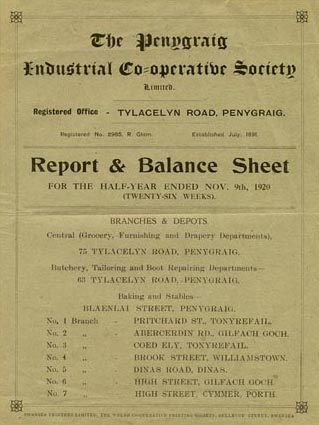 |
| ELY COLLIERY, PENYGRAIG PIT DISASTER 1909 | |
At 5.50 am on the 27th of August 1909 at the Ely Pit, one of three pits owned by the Naval Colliery Company, 28 men were descending to the pit at the start of their shift, when a disaster occurred that would kill seven of the miners and injure twenty-one others. The cage the men were descending in instead of slowing down as it reached the bottom of the shaft continued to speed up and landed at the bottom of the shaft with ‘some force'. This caused the ascending empty cage to shoot up the shaft into the headgear breaking the rope and subsequently descending the shaft partly landing on the other cage killing some of it's occupants. As the Rhondda Leader of the time describes: ‘ Five of those in the upper deck (of the cage) being instantaneously killed, while the more seriously injured died soon after they were released. Two of the killed were severely mangled, whilst another was almost decapitated. Those in the lower bond bared better than their unfortunate comrades, and all of these escaped with their lives though some were badly injured sustaining fractures of limbs and body.' |
|
